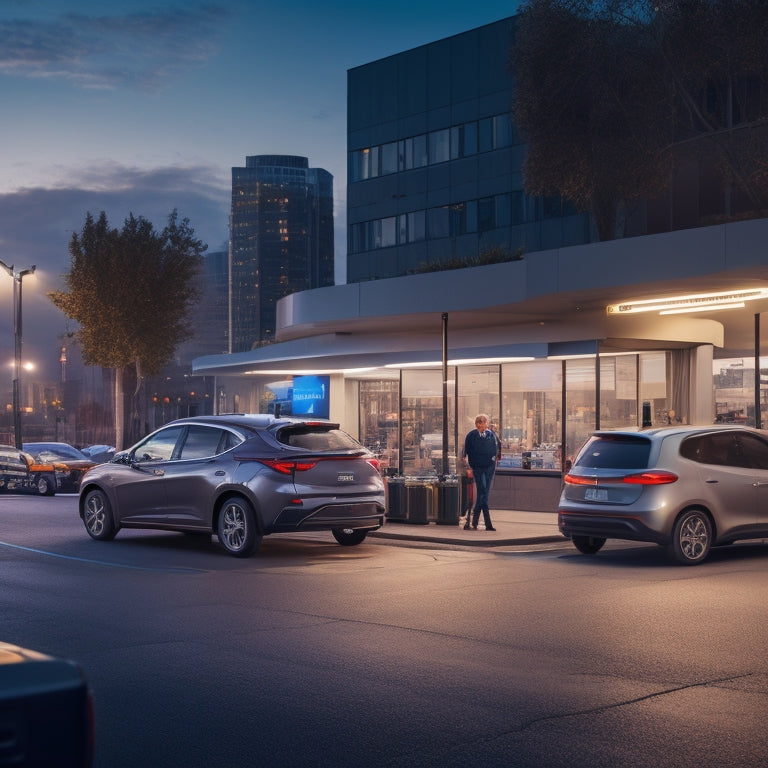
Public Skepticism Lingers: Electric Vehicle Adoption Challenges
Share
Public skepticism towards electric vehicles (EVs) persists, driven by concerns over limited charging infrastructure, high upfront costs, and battery durability and replacement costs. Additionally, varying beliefs on EVs' emission reduction potential and climate impact contribute to the hesitation. However, a majority of consumers are open to buying EVs in the future, highlighting a need for education and infrastructure development to address range anxiety fears. As the EV market continues to evolve, understanding these challenges is essential for fostering a favorable environment for adoption, and exploring these complexities further can provide valuable insights into overcoming these hurdles.
Key Takeaways
• Public skepticism towards electric vehicles (EVs) persists, driven by concerns about range, charging time, cost, and infrastructure limitations.
• Range anxiety remains a significant barrier to EV adoption, with education campaigns and infrastructure expansion crucial to addressing concerns.
• The lack of comprehensive and reliable charging infrastructure hinders EV market growth, with uneven distribution and insufficient grid capacity major obstacles.
• Government-backed incentives, such as tax credits, play a vital role in driving EV adoption, as demonstrated by Norway's successful EV adoption model.
• Sustained policy support is necessary to create a favorable market environment, promoting industry partnerships and EV infrastructure development.
Electric Vehicles' Limited Adoption
Despite growing interest in environmentally friendly transportation, electric vehicle (EV) adoption in the United States remains limited, with only 4% of Americans owning an EV, according to a Gallup poll. This limited interest can be attributed to various consumer concerns.
One major deterrent is the perceived limited range and charging time of EVs, making long road trips challenging. Additionally, high upfront costs and limited charging infrastructure in certain regions contribute to the hesitation. Moreover, concerns about battery durability and replacement costs also weigh on consumers' minds.
These concerns collectively hinder widespread adoption, underscoring the need for education and infrastructure development to alleviate these concerns and drive EV adoption forward.
Public Perception and Climate Change
A Gallup poll reveals that while a majority of Americans are open to buying electric vehicles in the future, public skepticism persists regarding the impact of EVs on climate change. This dichotomy highlights the need for increased public awareness and education on the role of EVs in mitigating climate change.
| Climate Change Perceptions | Public Awareness | EV Adoption |
|---|---|---|
| 45% believe EVs can greatly reduce emissions | 60% consider climate change a serious threat | 55% open to buying EVs in the future |
| 30% unsure of EVs' climate impact | 40% prioritize economic growth over climate action | 25% plan to buy an EV in the next 5 years |
| 20% believe EVs have no climate impact | 30% believe climate change is exaggerated | 15% own an EV currently |
| 5% believe EVs worsen climate change | 10% deny climate change existence | 10% prioritize EVs for environmental benefits |
Overcoming Range Anxiety Fears
Range anxiety, a pervasive concern among potential electric vehicle adopters, stems from uncertainty about the distance an EV can travel on a single charge. To alleviate this concern, education campaigns can play an essential role in educating consumers about the capabilities of EVs.
By providing accurate information on the average range of EVs and the locations of charging stations, potential adopters can feel more confident in their purchasing decision. Additionally, the expansion of charging networks can also help to mitigate range anxiety fears.
As charging infrastructure continues to grow, consumers will have greater access to charging points, reducing the likelihood of being stranded without a charge. By addressing range anxiety through education and infrastructure development, we can increase consumer confidence and accelerate the adoption of electric vehicles.
Infrastructure Challenges Remain
The widespread adoption of electric vehicles is impeded by the lack of thorough and reliable charging infrastructure. This poses a significant obstacle to the growth of the EV market. A detailed charging network is essential to alleviate range anxiety and facilitate seamless travel.
Currently, the charging infrastructure is inadequate, with uneven distribution and limited access, particularly in rural areas. Additionally, the existing grid capacity is insufficient to support the increased demand from widespread EV adoption.
Upgrading the grid and expanding the charging network are vital to addressing these infrastructure challenges. The development of a robust and reliable charging infrastructure is essential to drive the growth of the EV market and achieve the desired environmental benefits.
Policy Support and Incentives
Government-backed incentives and policy support are essential to fostering a conducive environment that encourages the mass adoption of electric vehicles. This is evident in countries like Norway, where generous incentives have propelled EVs to comprise over 50% of new car sales.
In the United States, government incentives, such as tax credits, have played a vital role in driving EV adoption. Industry partnerships have also been instrumental in promoting the development of EV infrastructure. Collaborations between charging companies and automakers, for instance, have expanded the availability of charging stations, alleviating range anxiety concerns.
To accelerate EV adoption, sustained policy support and incentives are necessary to create a favorable market environment. These measures encourage consumers to switch to eco-friendly transportation options.
Frequently Asked Questions
How Do Evangelical Christians View Electric Vehicles and Climate Change?
Evangelical Christians' views on electric vehicles and climate change are shaped by moral obligation, faith-based activism, and theological perspectives, with some embracing Christian stewardship, while others remain skeptical, highlighting the complexities of evangelical identity.
Does the Biden Administration's 2030 Target Consider Infrastructure Limitations?
As the 2030 deadline looms, the Biden administration's target faces a critical hurdle: infrastructure limitations. Specifically, the charging grid's rural access shortcomings threaten to hinder widespread adoption, underscoring the need for strategic investments in underserved areas.
Are Electric Vehicles More Expensive Than Gasoline-Powered Cars Long-Term?
While electric vehicles often have higher upfront costs, long-term cost dynamics favor EVs, as fuel savings from reduced energy consumption and lower maintenance requirements can offset initial investments over time.
Can Electric Vehicle Batteries Be Recycled or Repurposed Efficiently?
As the electric vehicle revolution accelerates, a pressing concern emerges: can batteries be efficiently recycled or repurposed? The answer lies in maximizing battery life and energy storage systems, enabling a sustainable future for EVs.
Do Western U.S. States Have More Electric Vehicle Charging Stations per Capita?
Western U.S. states generally have higher electric vehicle charging station densities, attributed to urban planning, state incentives, and higher population densities, although rural accessibility and geographic disparities persist, necessitating targeted infrastructure development.
Related Posts
-

Why Merge Earth's Heat With Sun's Energy?
You're about to utilize the full potential of renewable energy by combining the Earth's natural heat with the Sun's a...
-

3 Earth-Loving Furniture Tips for Energy-Smart Homes
When furnishing your energy-smart home, you have the power to reduce your carbon footprint greatly by making consciou...
-

What Air Purifiers Save Energy in Work Areas?
You can cut energy costs and reduce your carbon footprint by choosing air purifiers designed with energy efficiency i...


